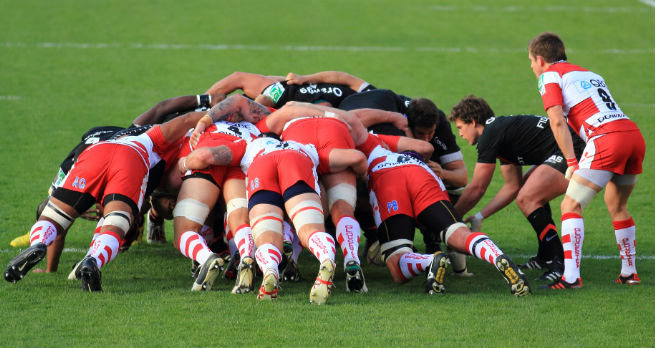The legendary American Football coach Vince Lombardi once said “Football is not a contact sport, it’s a collision sport – dancing is a contact sport”. This is equally applicable to the various codes of rugby, which captivate audiences with player-on-player impacts.
And from time to time, a tackle gone wrong results in serious injury, as we saw when Newcastle forward Alex McKinnon broke his spine after landing on his head.
So, how big are the collisions in rugby? And how can we reduce the risk of injury from that force?
 Must a physical game always lead to physical injuries?
Must a physical game always lead to physical injuries?
In rugby union, there are multiple forms of collisions – in the tackle, joining rucks and mauls (which can end up looking like a pile-up of bodies), scrum engagement (where players form rows and literally go head to head with their opponents), or even with the ground.
In an analysis of Bledisloe Cup rugby matches between Australia and New Zealand in 2004, researchers counted an average of nearly 500 collisions in a game: 26 scrums, 200 rucks and mauls, and 270 tackles.
In rugby league, the scrums are fewer and less contested, and rucks and mauls non-existent. Tackles, while less frequent, are no less fierce. In 2011, Sydney researchers recorded on average, 111 tackles per game among professional players.
Inadvertent collisions can be added to the number of impact events in a game, along with all the collisions in training that often go unreported.
The force involved in a player-on-player clash is related to the speed immediately before and after the collision, the mass (weight) of the bodies involved, the duration of impact and where on the body the impact occurred (soft abdomen or rigid shoulder).
But measuring the impact mass of the player(s) involved in the collision is not as simple as it appears. It’s not just the body weight of the player – it can be a lot less, as arms and legs may be free to swing during the moment of impact and therefore don’t contribute to the impacting mass calculations.
Also, whether the impact was direct or oblique will affect the impact force.
To get around this, several research teams have attempted to measure tackle impacts using instrumented training sleds, tackle bags and, more recently, instrumented shoulder pads. Using shoulder pads, Australian researchers reported rugby shoulder tackles had an average force of 1997 newtons (1997N), the equivalent of 206kg.
Researchers from the United States have reported much larger forces among American Football players. The athletes hit an instrumented tackle training sled at 3013N, or almost one third of a tonne; while the force of an instrumented helmet-on-helmet impact during games was as around 7191N, or nearly three-quarters of a tonne.
This shows the cushioning effect of impacting softer body parts in unprotected rugby players compared to padded and helmeted American Football players. It increases the time over which the collision takes place and lessens the impact of the force.
The stresses experienced by front-row forwards during rugby union scrummaging are also substantial. An international research team recorded forward-directed forces of up to 7982N (more than three-quarters of a tonne), as players packed down against an instrumented scrum machine. The hooker alone (the player at the centre fo the scrum) carries up to 3778N (385kg).
In 2007, the International Rugby Board introduced the “crouch-touch-pause-engage” sequence in all levels of rugby to control these large forces during scrum engagement. These rules were trialled at the school level in Australia in the 1980s and had an immediate effect on reducing catastrophic neck injuries to almost zero.
The high average number of high-energy impact events in a game demonstrates the dynamic and physical nature of both rugby codes and helps explain the high level of attrition experienced by players. As players get bigger, train more intensively and get faster, the collisions are going to get harder.
Sports administering bodies must therefore improve their management of collision events, particularly at the lower playing levels, where players are less mature or not as well prepared physically for the demands of the game. This can be done by teaching and enforcing correct technique.
Increased muscular development allows players to better resist force and is something all players can easily attain. But it can also make them heavier and faster, so the impact forces can be greater. Ironically, it is the most highly trained, strongest and fittest players who are most frequently injured because of the increased collision energy.
Unfortunately, body padding does not provide the protection players would hope for. While it might absorb some direct impact to the torso or head, it will not protect the limbs or joints from injury, and may encourage a player to use unsafe techniques, taker greater risks and engender a false sense of security during an impact.
Tactics such as other players recklessly entering rucks and mauls, shoulder charges, or second and third tacklers coming in late to effect the tackle, all add to the risk of injury. Referees and judiciaries have tightened up on these dangerous tactics in recent years in an attempt to eliminate them from the game.
While it is impractical to alter the nature of rugby to the extent where all risk is eliminated, it’s easy to make the game safer without significantly altering the collision aspect that makes rugby so attractive.
This article was originally published on The Conversation. Read the original article.
Rate and Review
Rate this article
Review this article
Log into OpenLearn to leave reviews and join in the conversation.
Article reviews